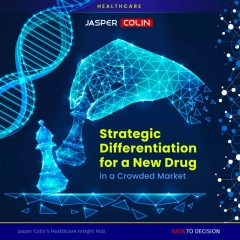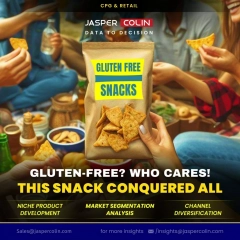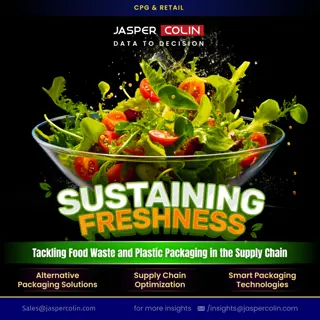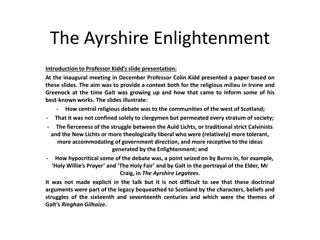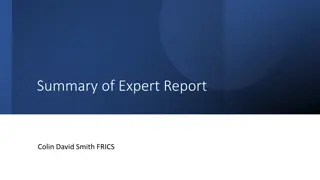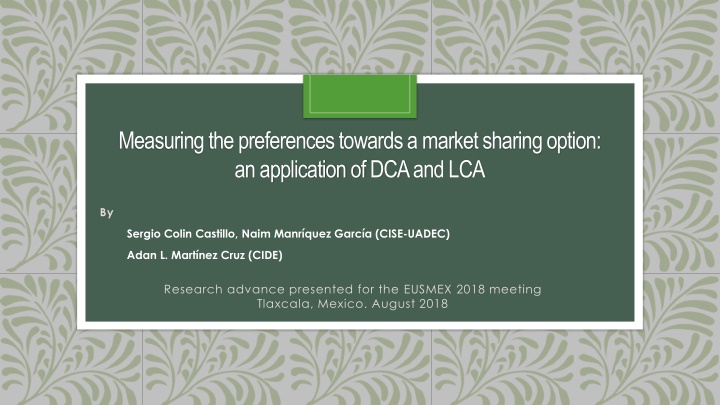
Exploring Mexican Farmers' Preferences in Market Sharing Options
"This study investigates Mexican farmers' willingness to adopt organic farming practices through a collaborative arrangement, revealing insights on education, group cohesion, and pricing preferences that influence their decisions. The research demonstrates contrasts between traditional and organic farmers in their attitudes towards chemical pesticide use and price fluctuations, highlighting the potential societal and environmental benefits of collaborative arrangements in agriculture."
Download Presentation

Please find below an Image/Link to download the presentation.
The content on the website is provided AS IS for your information and personal use only. It may not be sold, licensed, or shared on other websites without obtaining consent from the author. If you encounter any issues during the download, it is possible that the publisher has removed the file from their server.
You are allowed to download the files provided on this website for personal or commercial use, subject to the condition that they are used lawfully. All files are the property of their respective owners.
The content on the website is provided AS IS for your information and personal use only. It may not be sold, licensed, or shared on other websites without obtaining consent from the author.
E N D
Presentation Transcript
Measuring the preferences towards a market sharing option: an application of DCAand LCA By Sergio Colin Castillo, Naim Manr quez Garc a (CISE-UADEC) Adan L. Mart nez Cruz (CIDE) Research advance presented for the EUSMEX 2018 meeting Tlaxcala, Mexico. August 2018
Summary By means of a DCE, we explore the willingness of a group of Mexican farmers to adopt the organic production, a collaborative arrangement (economia solidaria) based on four characteristics: i) to implement chemical/pesticide-free farming practices, ii) to receive management support from the municipality, and iii) to set up a communal insurance scheme iv) Price market As a result, a two-class LCL delivers the following insights: 1. More experience and more education are associated with the probability of being a type of organic farmer 2. Also, more group cohesion and willingness to adopt a communal insurance scheme is also associated with being classified as a type of organic farmer. The willingness to receive support and work with the municipal government is not clear for both type of farmers 3. Importantly, traditional type of farmers are unwilling to give up chemical pesticides use while organic farmers significantly reject the use of such input 4. Last, on one hand, It looks like organic farmers do not care for a price increase, but they are willing to accept a slight price reduction. On the other hand, non organic farmers really cares for price movements, but mainly look for a price increase
Introduction Most farmers worldwide practice conventional farming in the sense that their production is based on synthetic chemical inputs. Indeed, the chemical inputs increase productivity at the expenses of: Soil quality (Virto et al, 2014; Cox, 2013; Gorniero, 2013), Biodiversity (Takeshi-Aida, 2016; Shakhramanyan et al., 2013), Human health (Sparling et al., 2017), and Social equity (FAO, 2013). Instances in Mexico are plenty: Chiapas: particles of organochlorine pesticides have been detected in pygmy owls (Arrona-Rivera et al., 2016). Mexico City have found presence of organochlorine pesticide residues in bottled drinking water (Diaz et al., 2009) Sinaloa, contaminated fish by pesticides, that puts in risk the people who consume them (Granados-Galvan, 2015).
Collaborative arrangements (named here as: Sharing Economy or Economia Solidaria in Spanish) have been documented to decrease negative externalities from conventional farming practices. An instance, the role of government policies in influencing maize diversity in Chiapas, Mexico (Keleman et al., 2008), Farmers social arrangements in Oaxaca, Mexico where farmers collective action play an important role in local seed supply (Badstue et al., 2009). Organic agriculture, as a case of collaborative arrangement (sharing economy: econom a solidaria: ES), offers a number of societal benefits including the protecting nature, maintaining biodiversity, improving scenery, and supporting communities
In a broader perspective the authors who have studied organic farming practices through the discrete choice experiments (DCE) have focused: I. Pesticides free: Aslam, (2017); Ch ze and Martinet., (2017); Christensen et al., (2011); Espinosa-Goded et al., (2010); Ruto and Garrod, (2009); Birol et al., 2009 II. Cover crops III. Buffer zones But, what about the main drivers or motivations to adopt such practices?
Related Literature: Collaborative arrangements Partnerships arrangements and collaboration among farmers has been studied in agriecological economy: Collaboration may involve one or several activities at the farm such as cultivation, planting, fertilizer application, pesticide application and harvest but also the role of social norms. One of the probably most important potential gains from collaboration is reduced cost of capital and risks.
For the case of empirical evidence, particularly the DCE; most of the literature focuses on the possible economic advantages for their members: 1) Andersson et al., (2005); 2) Artz et al., (2010); 3) Aurbacher et al., (2011), 4) Asai and Langer (2014), 5) Feil et al., (2015).
Empirical Approach Random utility (RU) models are methods for describing discrete choice behavior. Accordingly, it is possible to determine a utility function. ???= ???+ ??? = ? ???+ ???, ? = 1,2, ..,? (1) where, the individual chooses the alternative in a choice situation which gives his maximum utility, i.e., ??? > ???, ? ? (Train, 2003).
An extension on this type of utility models to analyze DCE are conditional logit, random parameter logit and latent class logit model. The CL choice probability that individual ? chooses alternative ?: exp(? ???) ? exp(? ???) (2) ???= ?=? The random parameter logit choice probability that individual ? chooses alternative ?: exp ? ??? ? exp ? ??? ?(?)?(?) (3) ???= ? ?=1
The latent class logit choice probability that individual ? chooses alternative j belonging to class g is: exp(? ???) ? exp(? ???), ? = 1,2, .,? (4) ???|?= ?=1 Then, in accordance with Swait (2007), the probability of individual ? in class ? can be expressed as: exp(? ???) ?=1 exp(? ???) (5) ???= ?
Combining classification equation (5), the unconditional probability of choosing alternative ? is given as: conditional choice equation (4) and membership exp(? ???) ? exp(? ???) ?=1 exp(? ???) (6) ? ? ??? = ?=1 ???|????= ?=1 exp(? ???)? ? ?=1 Therefore, the central issue in the LC model is how to determine ?. The most common criteria to determine G are AIC and BIC criterion: ??? = 2????+ 2?? ??? = 2????+ ????? (7)
Data: Choice of the attributes and their levels A first step for the DCE was to choose the attributes and their Table 1. Attributes and attribute levels used in the choice experiment Attribute Levels associated levels. Use of agrochemicals 1. No use 2. Use 1. Not management 2. Management 1. Cooperative 2. No cooperative 1. Increase 2. No increase 1. Reduction 2. No reduction For collecting data, we have made a questionnaire: Management with government aid The first part was dedicated to general questions regarding the Cooperative Scheme farmer s context. Price increase of a 30% The rest of the survey was the discrete choice experiment using illustrated slides and describing in detail the attributes. Price reduction of a 10%
Table 6. Estimates of the conditional logit model Variables Entire 0.964*** (0.121) 0.356** (0.118) Traditional -0.335 (0.236) 1.206*** (0.287) Organic farmers 2.847*** (0.278) 0.991*** (0.166) Use of agrochemicals (1 = No use, 0 = Use) Management with government aid (1 = Not management, 0 = management) Cooperative Scheme (1 = Cooperative, 0 = 1.009*** (0.124) 2.439*** (0.276) 0.262 (0.237) no cooperative) Price increase of a 30% (1= Increase, 0 = No 0.572*** (0.150) -0.336* (0.138) 1314 -705.59 0.1043 1.083*** (0.253) -2.053*** (0.348) 504 -370.61 0.2668 0.0048 (0.227) -0.108 (0.180) 810 -221.54 0.2368 increase) Price reduction of a 10% (1 = Reduction, 0 = no reduction) N Log likelihood adj. R-sq Standard errors in parentheses Note: *, ** and *** indicate statistical significance at the 90%, 95% and 99% levels, respectively.
Results To compare LC models and determine the number of classes, we used: AIC and BIC criterions. Table 2. AIC and BIC values for different numbers of classes (without membership) Table 3. AIC and BIC values for different numbers of classes (with membership) Traditional farmers Organic farmers Traditional farmers Organic farmers Number of classes Number of classes BIC AIC BIC AIC BIC AIC BIC AIC 2 231.95 219.96 166.13 146.25 2 211.77 190.45 186.06 157.15 3 245.38 226.73 185.58 154.87 3 304.73 268.76 211.77 162.99
Table 4. Estimates of the latent class model Variable Class 1 -1.535*** (0.243) Class 2 8.631*** (1.332) Use of agrochemicals (1 = No use, 0 = Use) Management w/government aid (1 = Not management, 0 = 1.473*** (0.196) -15.918*** (2.304) management) Tabla 4. LC Membresia Conventional -0.881*** (0.333) 1.041** (0.544) Cooperative Scheme (1 = Cooperative, 0 = no cooperative) 0.254 (0.280) 7.991** (1.164) Price increase of a 30% (1= Increase, 0 = No increase) -78.185 (74.320) -6.508*** (1.011) 0.283 (0.656) -1.772** (0.945) -0.130*** (0.042) Price reduction of a 10% (1 = Reduction, 0 = no reduction) Gender Highschool Experience
Social cohesion measures Times respondent invites people from the market to his/her house Other economic activity besides -2.097*** (0.781) -1.192 (0.736) 5.187 (1.572) 0.601 market C Class share 0.399 Note: *, ** and *** indicate statistical significance at the 90%, 95% and 99% levels, respectively.
Table 5. Marginal effects latent class Variable LC1 LC2 -.011** (.046) -1.535*** (.243) Use of agrochemicals (1 = No use, 0 = Use) Management with government aid (1 = Not management, 0 = management) Cooperative Scheme (1 = Cooperative, 0 = no cooperative) Price increase of a 30% (1= Increase, 0 = No increase) Price reduction of a 10% (1 = Reduction, 0 = no reduction) Standard errors in parentheses Note: *, ** and *** indicate statistical significance at the 90%, 95% and 99% levels, respectively. 1.473*** (.196) 1.450*** (.492) -0.881*** (.333) .003*** (.031) 0.254 (.280) -6.508*** (1.011) .234 (.755) -1.82*** (.945)
Conclusions Exploring the farmers choice-decision to switch from conventional to organic farming, or to adopt SE scheme, our analysis reports that: More experience and more education are associated with the probability of being of the first type of farmer (SE) Also, more group cohesion is also associated with being classified as the first type of farmer General critique (warning) to DCE: Whether people understand and/or pay attention to all attributes. In our case, readers might get suspucious of the fact that our respondets do not react to pesticide-free attribute
Appendix Table 2. AIC and BIC values for different numbers of classes (without membership) Traditional farmers BIC Organic farmers BIC Entire Number of classes BIC 470.93 445.73 231.95 219.96 166.13 146.25 457.56 418.62 245.38 226.73 185.58 154.87 452.69 400.01 252.71 227.40 208.42 166.87 477.20 410.77 260.64 228.67 228.14 175.75 AIC AIC AIC 2 3 4 5
Table 3. AIC and BIC values for different numbers of classes (with membership) Traditional farmers BIC Organic farmers BIC Entire Number of classes BIC AIC AIC AIC 365.63 360.69 392.3 2 3 4 5 404.57 427.11 486.2 211.77 304.73 314.01 261.39 190.45 186.06 157.15 268.76 211.77 162.99 263.38 250.49 181.84 196.11 349.12 260.6 -


